This post may contain affiliate links. Please read my disclosure policy.
This Lemon Dill Pan Fried Salmon really is simplicity at its finest. In 20 minutes you can have this incredibly delicious lemon dill salmon that requires only a handful of ingredients!
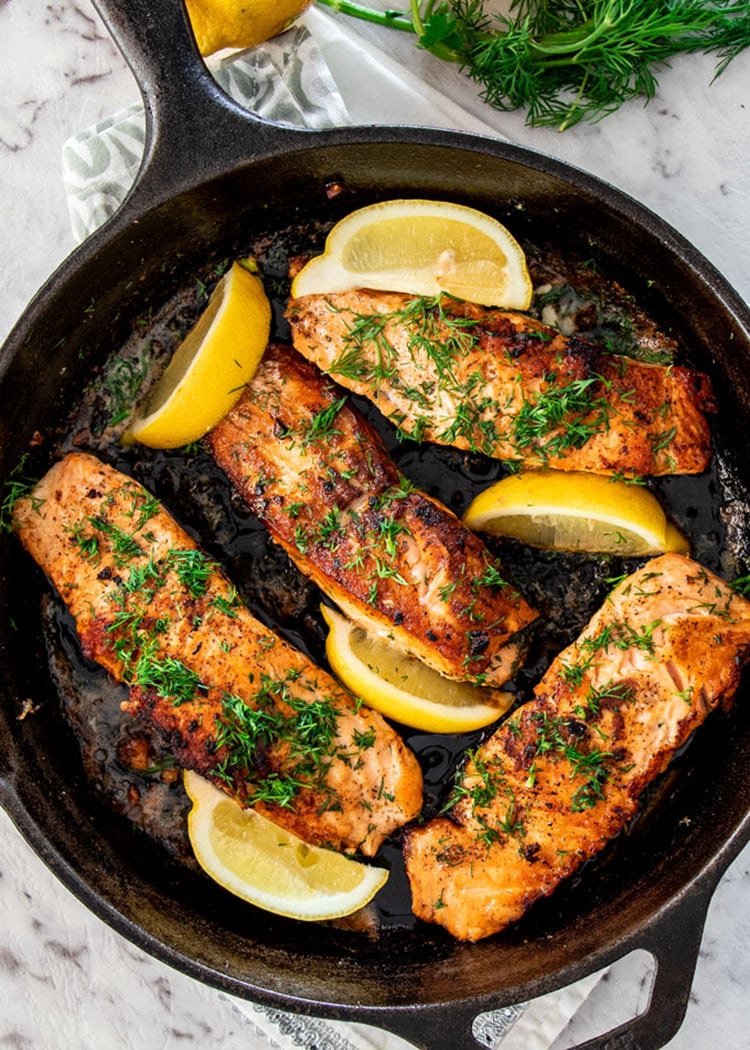
I used to love eating salmon, it was pretty much the only thing I’d order whenever we’d go to a restaurant. Until one day I had enough, and stopped eating salmon for years. But in my forever quest of cooking and eating healthier (not always successful), I brought salmon back into our diets with this gorgeous Lemon Dill Pan Fried Salmon!
Why You’ll Love This Salmon
- Made Entirely In One Pan
- Takes 20 Minutes Total
- Simple, Short Ingredient List
- Incredibly Easy To Make
- Healthy & Delicious
On the occasions that I do cook with salmon, I like to keep it simple, same with my other recipes. However, one of my all time favorite ways to have salmon is pan seared with fresh lemon juice and lots of dill. As a matter of fact, when I think of what goes well on salmon, lemon and dill always come to mind first! It’s like a match made in heaven. This recipe is made entirely in one pan, in just 20 minutes, making it the perfect healthy, weeknight meal!
Ingredients You’ll Love
- Salmon – I used skinless salmon, cut into 4 fillets.
- Olive Oil – Substitute sunflower, safflower or avocado oil.
- Butter – I used unsalted to control the sodium. If you use salted you won’t have to add as much when seasoning.
- Seasoning – Salt & pepper, to taste. Season to your liking!
- Lemon Juice – If anything, I highly recommend using freshly squeezed lemon juice for this recipe.
- Dill – I like using fresh dill, chopped.
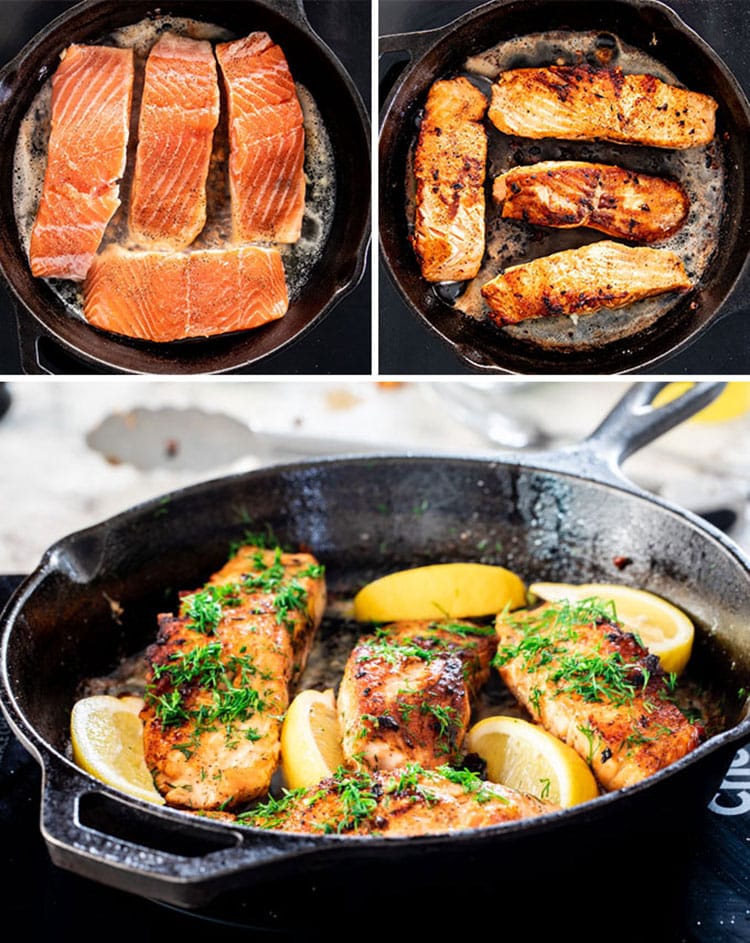
- Prep Salmon: Take out the salmon fillet 15 minutes prior to cooking. Pat dry the salmon fillets using a paper towel or a clean dish towel. This will prevent them from sticking to the skillet.
- Heat Oil: Heat a skillet over medium-high heat. Use a cast iron skillet or a stainless steel skillet. Add the olive oil and butter and heat until butter melts and starts to bubble. Make sure the oil and butter coats the entire surface of the skillet.
- Season Fillets: Season the salmon with salt and pepper just before adding to the hot skillet, then add the fillets to the pan. If using fillets with skin, place skin-side down first. I usually can add all 4 fillets at once and my skillet is 10 1/4 inches in diameter.
- Cook: Cook the fillets for about 6 to 7 minutes for the first side. The first side takes the longest to cook. As the fish cooks you’ll notice the color of the fillet will begin to lighten, starting at the bottom.
- Finish: Flip the fillets and cook for an additional 3 minutes on the other side. When you try to flip the fillets if they don’t release easily, cook for another minute until they release. The salmon is done cooking when it looks opaque. Remove from heat.
- Garnish & Serve: Sprinkle the salmon with the freshly squeezed lemon juice and garnish with lots of dill. Serve immediately.
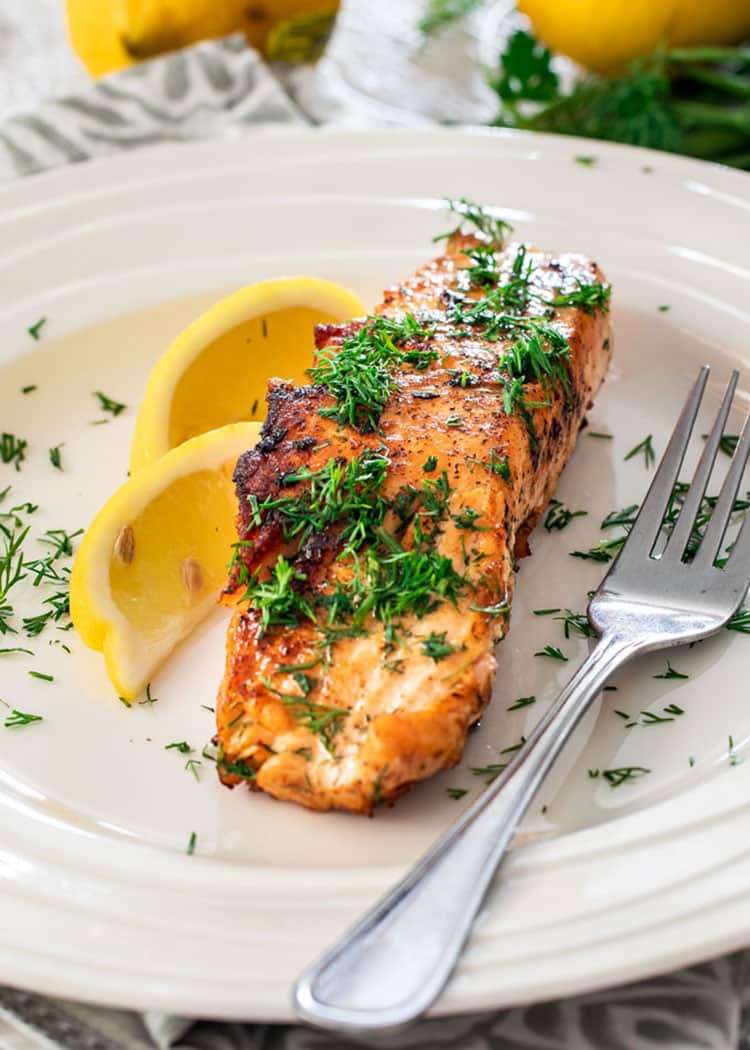
Frequently Asked Questions
Can I Use Salmon With The Skin On?
You can! Just keep in mind, if using fillets with skin, place skin-side down first when cooking.
How Do I Know When My Salmon Is Done Cooking?
As the fish cooks you’ll notice the color of the fillet will begin to lighten, starting at the bottom. The salmon is done cooking when it looks opaque.
Can I Used Dried Dill For This?
I do prefer using fresh dill for this recipe, however if you only have dried herbs on hand that you’d like to use up, you can most definitely substitute them in for this recipe! Just keep in mind that 1 tablespoon fresh equals 1 teaspoon dried herbs so don’t go too overboard!
How To Serve
Fresh lemons are a must! Once the salmon is done, add a squeeze of fresh lemon over top and you’ll be in heaven. This salmon works with many side dishes, if you want to keep it healthy, add a salad on the side, or some healthy roasted veggies. No matter what you choose to serve this salmon with, you’re going to love every last bite.
Expert Tips
- Bring the salmon to room temperature before cooking the fillets. If cold fish is added to a hot pan, the fillet will seize up and will cook unevenly. Taking the fish out of the fridge about 15 minutes prior to cooking is ideal.
- Pat down the salmon with paper towels to dry before actually adding the salmon to the skillet. If the fillets are moist or wet they are more likely to stick to the pan.
- Make sure your skillet is really hot before cooking and then keep the heat to a medium-high.
- Don’t try to flip the salmon if it’s sticking. When the salmon is cooked, it will release from the pan and you can easily flip it.
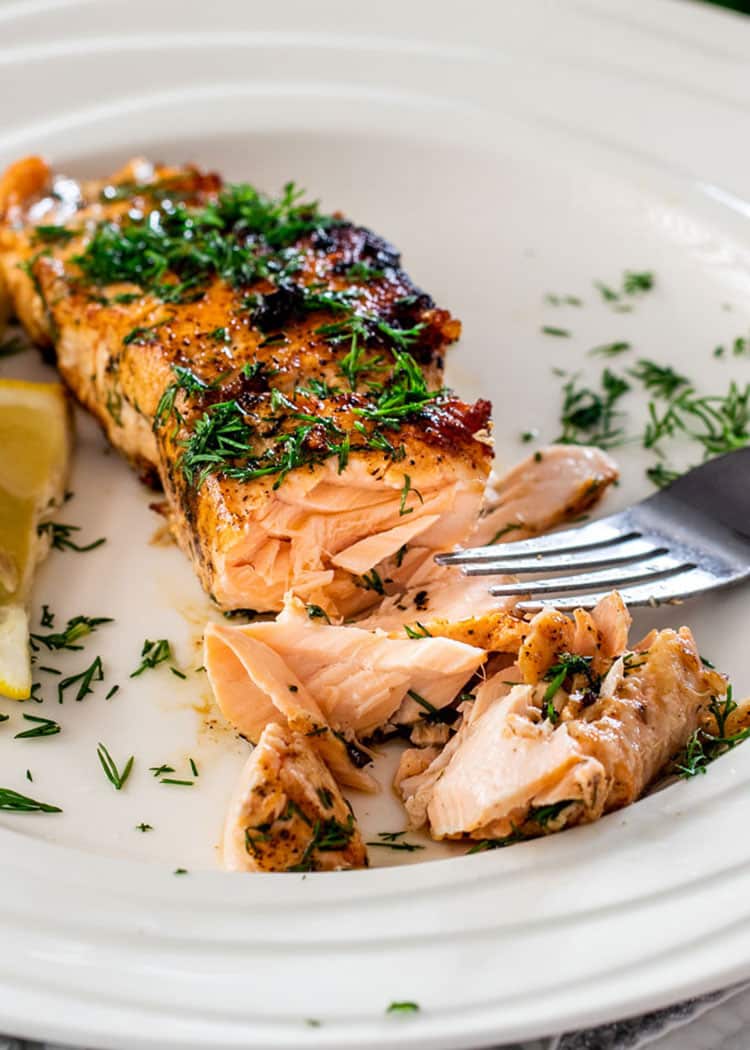
Storing Leftovers
Refrigerate leftover salmon in an airtight container for up to 3 days.
Freezing
You can also freeze this salmon! Pop it in an airtight container and store in the freezer for 4 – 6 months. Thaw in the fridge overnight, and heat back up in the oven when ready to eat.
More Related Recipes:
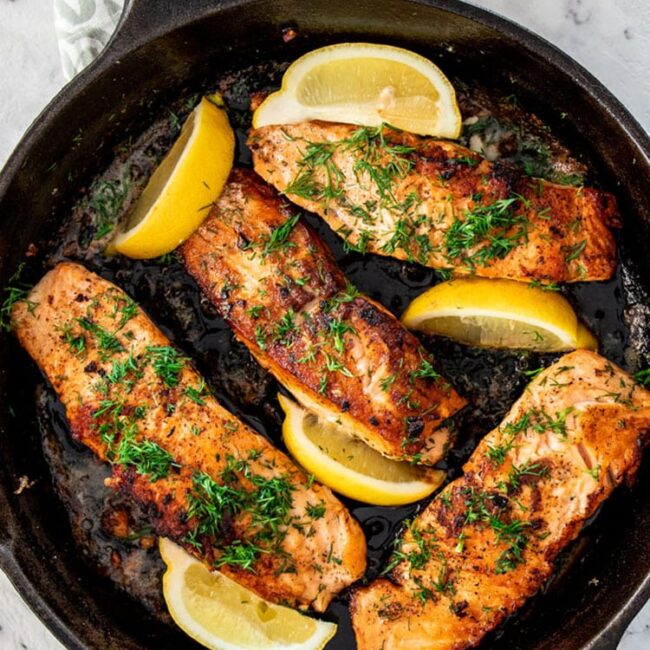
Lemon Dill Pan Fried Salmon
Equipment
Ingredients
- 1 pound salmon skinless, cut into 4 fillets
- 2 tablespoons olive oil
- 1 tablespoon butter
- ¼ teaspoon salt or to taste
- ½ teaspoon pepper or to taste
- 2 tablespoons lemon juice freshly squeezed
- 2 tablespoons dill fresh, chopped
Instructions
- Prep Salmon: Take out the salmon fillet 15 minutes prior to cooking. Pat dry the salmon fillets using a paper towel or a clean dish towel. This will prevent them from sticking to the skillet.
- Heat Oil: Heat a skillet over medium-high heat. Use a cast iron skillet or a stainless steel skillet. Add the olive oil and butter and heat until butter melts and starts to bubble. Make sure the oil and butter coats the entire surface of the skillet.
- Season Fillets: Season the salmon with salt and pepper just before adding to the hot skillet, then add the fillets to the pan. If using fillets with skin, place skin-side down first. I usually can add all 4 fillets at once and my skillet is 10 1/4 inches in diameter.
- Cook: Cook the fillets for about 6 to 7 minutes for the first side. The first side takes the longest to cook. As the fish cooks you'll notice the color of the fillet will begin to lighten, starting at the bottom.
- Finish: Flip the fillets and cook for an additional 3 minutes on the other side. When you try to flip the fillets if they don't release easily, cook for another minute until they release. The salmon is done cooking when it looks opaque. Remove from heat.
- Garnish & Serve: Sprinkle the salmon with the freshly squeezed lemon juice and garnish with lots of dill. Serve immediately.
Tips & Notes:
- Bring the salmon to room temperature before cooking the fillets. If cold fish is added to a hot pan, the fillet will seize up and will cook unevenly. Taking the fish out of the fridge about 15 minutes prior to cooking is ideal.
- Pat down the salmon with paper towels to dry before actually adding the salmon to the skillet. If the fillets are moist or wet they are more likely to stick to the pan.
- Make sure your skillet is really hot before cooking and then keep the heat to a medium-high.
- Don’t try to flip the salmon if it’s sticking. When the salmon is cooked, it will release from the pan and you can easily flip it.
- Refrigerate leftover salmon in an airtight container for up to 3 days.
- You can also freeze this salmon! Pop it in an airtight container and store in the freezer for 4 – 6 months. Thaw in the fridge overnight, and heat back up in the oven when ready to eat.

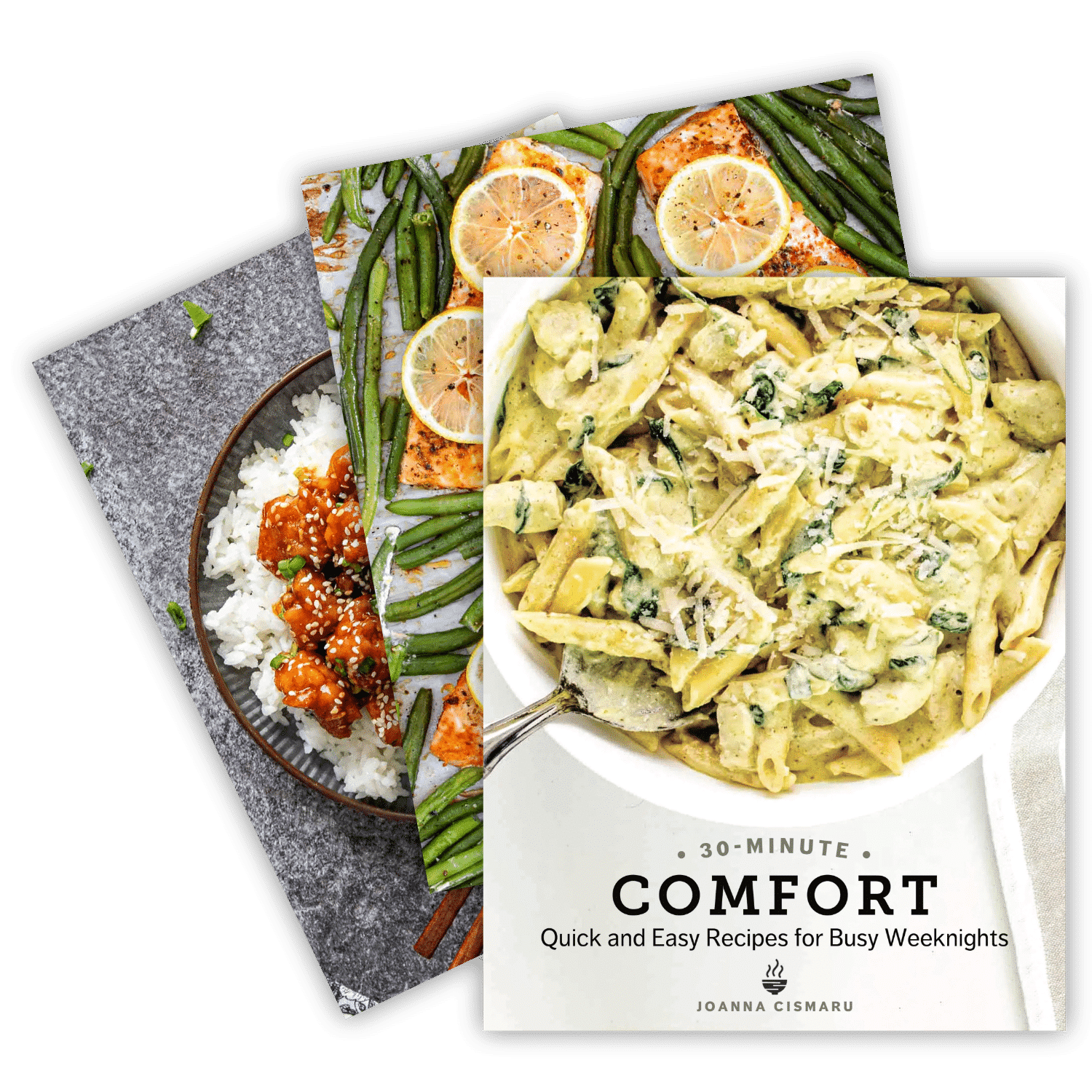


Wow! Just wow. This was this time I have ever tried pan seared salmon and it was amazing! My wife and daughter raved about it. Pan seared is the only way I will ever eat salmon again
Just made this super easy dish. Forgot to put salt and pepper on the fillets! Did use ghee for my fat and the favored cast iron pan. Microwaved the lemon before poking with a fork to get the juice out and only had dried dill weed.
Sooooooooo good! Perfect texture. I did leave the narrow edges of the fish folded over to preserve the thickness and nothing over cooked
I don’t usually cook. However, my wife bought some frozen salmon fillets. They were smaller than the ones shown. They mostly were thickest in the middle, and tapered to the edges, being cut across the salmon body. I was a bit worried that they might overcook at medium high heat, but I set the timer for 6 minutes about a minute after getting the fillets into the hot pan which had avocado oil and butter sizzling away. It was hot! They were delicious! The timing suggestions seemed to work, although I did begin to turn down the electric heat after turning.
This is the first time I have ever cooked salmon in my life. I used this recipe, and the salmon melted in my mouth!
Easy as 1-2-3! And yummy! Will make again. Do suggest if using Alaskan wild sockeye salmon, cut cooking time down by 2-3 minutes on first side. Thinner filets cook more quickly.
I love this recipe!! I cook for a 93 year old lady and this recipe brings out the best flavor of the salmon. I will continue to use this recipe for my own household as well as the people I take care of.
This recipe is so easy and delicious. This is my favorite recipe for pan seared salmon..thanks for this recipe and the helpful tips!
My pleasure, glad you enjoyed it!
I am using this recipe tonight!!! Ill let you know how it turns out… Is there a problem if i use canola oil instead of olive? And i also use smart butter spread…im a new diabetic and this is my first time dieting and trying to eat healthy really trying to find things i like..ive also never had salmon before but it was in my diabetic papers as a very healthy food so its worth a try…
Hi Nicole! You should be fine, I usually use olive oil because it’s better for you but use whatever you have or need to use. Do let me know how it turns out for you.
Making this today.
Let me know how you like it!
Delicious, easy recipe!
This sounds really good! Any tips for using frozen salmon fillets?
Just make sure they’re completely thawed before you use them.